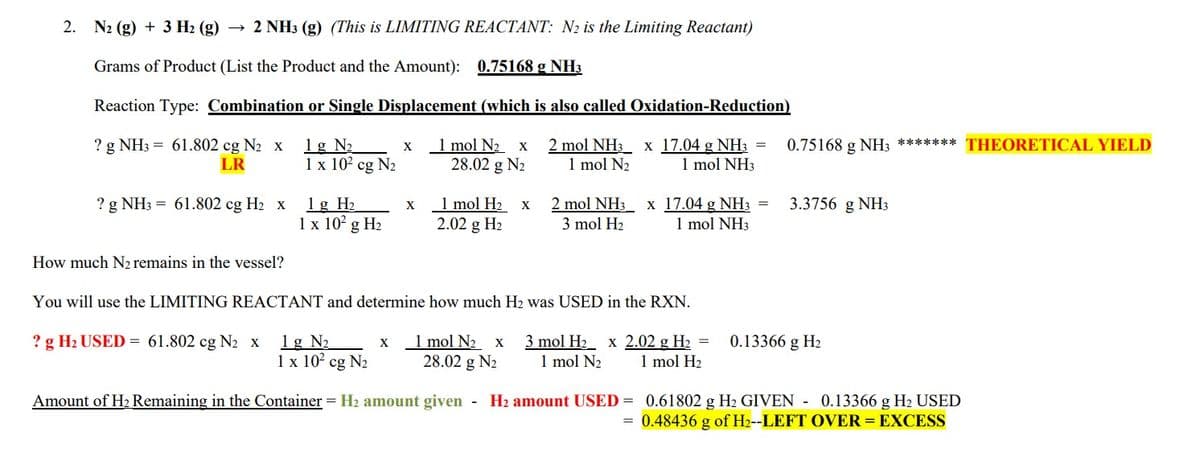Write the balanced equation for the following situation. List the reaction type. Tell the amounts of every substance that remains in the container at the end of the reaction. Assume that all reactions go to completion. If only stoichiometry, tell how much of the excess reactant is used!!!! Reaction Type: a. Combination Reaction b. Decomposition Reaction c. Single Displacement / THIS IS ONE TYPE OF Oxidation Reduction Reaction d. Precipitation Reaction e. Gaseous Reaction f. Neutralization Reaction g. Combustion Reaction Follow the format used in the image. 6.9 g sodium nitride forms sodium and nitrogen gas
Write the balanced equation for the following situation. List the reaction type. Tell the amounts of every substance that remains in the container at the end of the reaction. Assume that all reactions go to completion. If only stoichiometry, tell how much of the excess reactant is used!!!! Reaction Type: a. Combination Reaction b. Decomposition Reaction c. Single Displacement / THIS IS ONE TYPE OF Oxidation Reduction Reaction d. Precipitation Reaction e. Gaseous Reaction f. Neutralization Reaction g. Combustion Reaction Follow the format used in the image. 6.9 g sodium nitride forms sodium and nitrogen gas
Chemistry & Chemical Reactivity
9th Edition
ISBN:9781133949640
Author:John C. Kotz, Paul M. Treichel, John Townsend, David Treichel
Publisher:John C. Kotz, Paul M. Treichel, John Townsend, David Treichel
Chapter3: Chemical Reactions
Section: Chapter Questions
Problem 60GQ: Balance the following equations: (a) for the reaction to produce "superphosphate" fertilizer...
Related questions
Question
100%
Write the balanced equation for the following situation. List the reaction type. Tell the amounts of every substance that remains in the container at the end of the reaction. Assume that all reactions go to completion. If only stoichiometry, tell how much of the excess reactant is used!!!! Reaction Type: a. Combination Reaction b. Decomposition Reaction c. Single Displacement / THIS IS ONE TYPE OF
Follow the format used in the image.
6.9 g sodium nitride forms sodium and nitrogen gas

Transcribed Image Text:2. N₂ (g) + 3 H₂ (g) → 2 NH3 (g) (This is LIMITING REACTANT: N₂ is the Limiting Reactant)
Grams of Product (List the Product and the Amount): 0.75168 g NH3
Reaction Type: Combination or Single Displacement (which is also called Oxidation-Reduction)
1 g N₂
? g NH3 = 61.802 cg N₂ x
LR
2 mol NH3 x
1 mol N₂
17.04 g NH3 =
1 mol NH3
1 x 10² cg N₂
? g NH3 = 61.802 cg H₂ x
1 g H₂
1 x 10² g H₂
? g H₂ USED = 61.802 cg N₂ x
1 g N₂
1 x 10² cg N₂
X
X
X
1 mol N₂ x
28.02 g N₂
1 mol H₂
2.02 g H₂
How much N2 remains in the vessel?
You will use the LIMITING REACTANT and determine how much H₂ was USED in the RXN.
1 mol N₂ X 3 mol H₂ x 2.02 g H₂ =
28.02 g N₂ 1 mol N₂ 1 mol H₂
X
2 mol NH3 x 17.04 g NH3 =
3 mol H₂
1 mol NH3
Amount of H₂ Remaining in the Container = H₂ amount given - H₂ amount USED=
0.75168 g NH3 ******* THEORETICAL YIELD
3.3756
0.13366 g H₂
NH3
0.61802 g H₂ GIVEN 0.13366 g H2 USED
= 0.48436 g of H₂--LEFT OVER = EXCESS
Expert Solution
This question has been solved!
Explore an expertly crafted, step-by-step solution for a thorough understanding of key concepts.
Step by step
Solved in 2 steps with 2 images

Knowledge Booster
Learn more about
Need a deep-dive on the concept behind this application? Look no further. Learn more about this topic, chemistry and related others by exploring similar questions and additional content below.Recommended textbooks for you

Chemistry & Chemical Reactivity
Chemistry
ISBN:
9781133949640
Author:
John C. Kotz, Paul M. Treichel, John Townsend, David Treichel
Publisher:
Cengage Learning

Chemistry & Chemical Reactivity
Chemistry
ISBN:
9781337399074
Author:
John C. Kotz, Paul M. Treichel, John Townsend, David Treichel
Publisher:
Cengage Learning

Chemistry for Engineering Students
Chemistry
ISBN:
9781337398909
Author:
Lawrence S. Brown, Tom Holme
Publisher:
Cengage Learning

Chemistry & Chemical Reactivity
Chemistry
ISBN:
9781133949640
Author:
John C. Kotz, Paul M. Treichel, John Townsend, David Treichel
Publisher:
Cengage Learning

Chemistry & Chemical Reactivity
Chemistry
ISBN:
9781337399074
Author:
John C. Kotz, Paul M. Treichel, John Townsend, David Treichel
Publisher:
Cengage Learning

Chemistry for Engineering Students
Chemistry
ISBN:
9781337398909
Author:
Lawrence S. Brown, Tom Holme
Publisher:
Cengage Learning

Chemistry: The Molecular Science
Chemistry
ISBN:
9781285199047
Author:
John W. Moore, Conrad L. Stanitski
Publisher:
Cengage Learning

Chemistry: Principles and Practice
Chemistry
ISBN:
9780534420123
Author:
Daniel L. Reger, Scott R. Goode, David W. Ball, Edward Mercer
Publisher:
Cengage Learning

Chemistry by OpenStax (2015-05-04)
Chemistry
ISBN:
9781938168390
Author:
Klaus Theopold, Richard H Langley, Paul Flowers, William R. Robinson, Mark Blaser
Publisher:
OpenStax